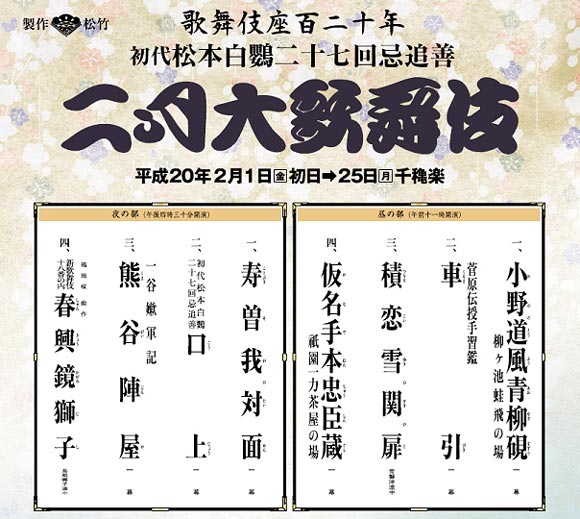| Comments |
This February program commemorates the 26th anniversary (27th memorial service) of the passing away of Matsumoto Haku˘.
The stars of this program are his two sons Matsumoto K˘shir˘ and Nakamura Kichiemon.
Ono no T˘fű: Ono no T˘fű is famous as one of the greatest calligraphers
in the history of Japan and legend has it that he was inspired by the sight of a
frog jumping onto a tall willow tree in the rain. This image has made it onto
a hanafuda card and was a stock story of pre-war moral education.
This month there is a very rare performance of a play that shows
Ono no T˘fű not only as a great calligrapher, but also as a powerful fighter.
After elegant court noble Ono no T˘fű (Nakamura Baigyoku) witnesses this scene, he fights with
Daroku (Band˘ Mitsugor˘) a red-faced warrior like a sum˘ wrestler.
The two unlikely combatants are evenly matched and this fight is an omen of
disturbances in the land and the two joining forces to bring peace.
Kurumabiki: this short but energetic play is a showcase for the
bombastic aragoto style of acting.
The brothers Ume˘maru (Onoe Sh˘roku) and Sakuramaru (Nakamura Kinnosuke) are retainers of the exiled
aristocrat Sugawara no Michizane. They try to take revenge on Fujiwara no Shihei,
the man who falsely accused their lord, but are confronted by their other brother,
Matsu˘maru (Nakamura Hashinosuke) who is a retainer of the villain Shihei. The two try to tear
apart Shihei's carriage but are stopped by Matsu˘maru and the powerful glare
of Shihei (Nakamura Karoku).
Seki no To:
(The Snowbound Barrier)
A snow-covered barrier decorated by a mysteriously blooming cherry tree provides
the background for the larger-than-life story of a traitorous aristocrat
disguised as a barrier guard and the beautiful woman, actually a supernatural
spirit in disguise, that will defeat him. Nakamura Kichiemon, Ichikawa Somegor˘ and Nakamura Fukusuke
star in what is considered to be one of the greatest Kabuki dance-dramas.
Gion Ichiriki Jaya: "Chűshingura" is one of
the most popular plays in the theatre and shows a true event when forty-seven
masterless samurai avenged the death of their lord by killing his enemy.
The seventh act is one of the most popular and shows the leader of the vendetta
Yuranosuke as he is hiding his intention to avenge his lordĺs death by pretending
to be only interested in pleasure, but also encountering key figures on
his side and the side of the enemy. Yuranosuke (Matsumoto K˘shir˘)
spends his days and nights in the pleasure quarters of Ky˘to in an effort to
make their lordĺs enemy, Moron˘, believe he is not planning a vendetta.
His acting is so good that even men in his own group believe he has given his
life up to pleasure. Moron˘ is not so easily convinced, though, and has sent spies,
including a former retainer of their late lord, En'ya Hangan, to find Yuranosuke's
true intentions. Okaru (Nakamura Shibajaku), the wife of one of the retainers is now a
courtesan at the Ichiriki Teahouse, unaware that her husband is dead.
Okaru's brother Heiemon (Ichikawa Somegor˘), a servant in the Hangan household,
has also come to the teahouse and the interaction of these characters
becomes a matter of life and death and ends with Yuranosuke preparing to
lead the vendetta.
Soga no Taimen: this is one of the oldest and most classical of all
Kabuki plays. In the Edo period, every January, plays appeared about the vendetta
carried out by the Soga brothers Jűr˘ and Gor˘ after eighteen years of hardship.
In "Soga no Taimen" the brothers confront Kud˘ Suketsune, the man responsible for
their father's death. More ceremony than play, it features each of the important
Kabuki character types, including the bombastic aragoto
style of Gor˘ and the soft wagoto style
of Jűr˘. This month features a cast headed by Living National Treasure Nakamura Tomijűr˘ as Kud˘
and some of the most popular young stars in Kabuki with Band˘ Mitsugor˘ as Gor˘ and
Nakamura Hashinosuke as Jűr˘.
K˘j˘: the close relationship between the actors and the audience
is shown by these stage announcements, lavish ceremonies to commemorate various
important events. In this case, all the stars of the cast assemble to remember
the late Matsumoto Haku˘. Featuring Living National Treasure Nakamura Jakuemon.
Kumagai Jin'ya: this play is a dramatization of the clash between the Genji general Kumagai Jir˘ Naozane
and the Heike warrior Taira no Atsumori at the battle of Ichi-no-Tani, one of the most famous passages of the epic
"Tales of the Heike". In the Kabuki version, on the cryptic orders of the Genji leader Yoshitsune,
Kumagai hides the enemy warrior Atsumori and has his own son take the warrior's place.
On the battlefield, Kumagai has to kill his own son in Atsumori's place.
Things become worse when his wife Sagami and Atsumori's mother Fuji-no-Kata arrive at his camp.
In the highlight of the play, he tells them the story of his mortal battle with Atsumori, keeping Atsumori's well-being and his own sacrifice a secret.
He then shows the head of Atsumori for inspection by his leader to see if he has interpreted his orders correctly.
This performance stars Matsumoto K˘shir˘ as Kumagai,
with Living National Treasure Nakamura Shikan as Kumagai's wife Sagami,
Nakamura Kaishun as Fuji-no-Kata,
Nakamura Baigyoku as Yoshitsune and
Ichikawa Danshir˘ as Midaroku.
Kagami Jishi: one of the most important dances for onnagata female
role specialists and is an audience favorite. The maidservant Yayoi performs an
auspicious lion dance for the Sh˘gun in his opulent palace, but she gradually finds
herself under the control of the lion spirit. In the second half of the dance,
the lion spirit itself appears and performs its crazed dance among peonies and
fluttering butterflies. Starring Ichikawa Somegor˘ as both Yayoi and the spirit of the lion.
Source: Earphone Guide website
|


